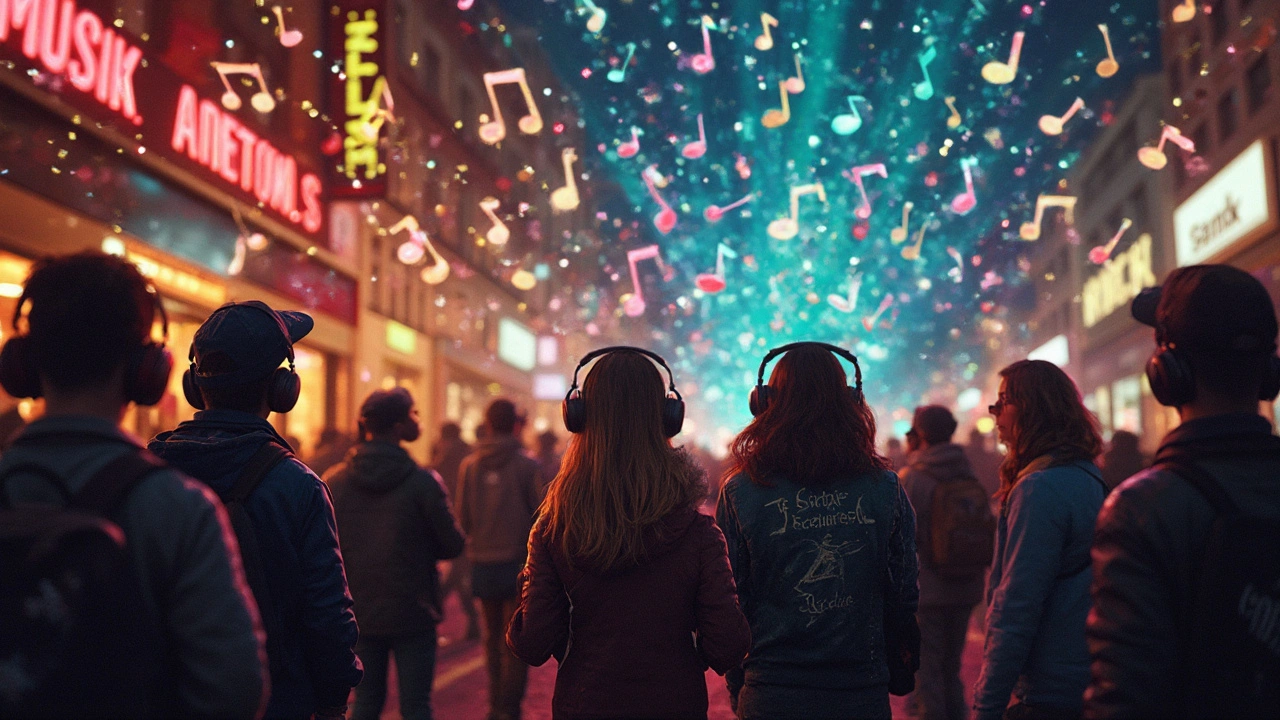Ever listen to a song and notice it just feels different—even if it’s tagged as rock or pop? Chances are, you just found a subgenre at work. Subgenres aren’t just labels music bloggers throw around. They help us zoom into the tiny tweaks and bold experiments that keep music fresh. Without them, everything would blur together.
Most big musical movements started as subgenres. Think grunge breaking off from punk and hard rock in the late ‘80s, or how lo-fi hip hop became a streaming sensation thanks to its chilled-out vibe. These splits aren’t random—they’re answers to what people are craving or gaps in how we hear music.
If you want to make sense of endless playlists or discover new favorite artists, understanding subgenres is usually the cheat code. For musicians, they offer a way to stand out and connect with a crowd that gets what they’re doing. For listeners, they’re like a road map to the good stuff that isn’t playing on every radio station.
- What Makes a Subgenre?
- How Subgenres Change the Scene
- Famous Subgenre Success Stories
- Why Musicians Chase Subgenre Trends
- Tips for Spotting What’s Next
What Makes a Subgenre?
So, what actually splits one type of music from its subgenres? The basics come down to sound, style, and culture. A subgenre pops up when a group of artists tries something new within the larger genre—tweaking beats, adding unique instruments, or focusing on a different vibe. For instance, pop punk spins off punk by bringing catchier hooks and softer vocals, while still keeping the energy high.
It’s never just about the music, though. Subgenres often come with their own uniforms, slang, or online communities. Metalheads know the difference between death metal and doom metal by guitar tone, vocals, and even how fast the drummer plays. In electronic music, a subgenre like drum and bass is defined by its breakbeat rhythms and fast tempo, totally different from the slow, atmospheric vibes of chillwave.
Fans and streaming services play a big role, too. Once people catch on and start creating playlists or hashtags for a new sound, the label sticks. According to Spotify’s own data, over 6,000 distinct genres and subgenres were tracked in 2023. That’s wild, but it shows just how much subgenre matters in the modern music world.
If you’re trying to spot a subgenre, ask yourself:
- Does it sound different enough from the main genre?
- Are certain artists leading the charge?
- Do fans use their own lingo or style in online spaces?
Once these patterns show up, you’re probably looking at a new subgenre in action. It’s kind of like watching a new street food trend turn into a local staple—except it’s all about the music in your headphones.
How Subgenres Change the Scene
Subgenres aren't just side notes—they totally shift the whole music game. Each time a new subgenre pops up, it brings along fresh energy and fresh faces. Take dubstep, for example. In the late 2000s, it turned electronic dance music on its head, dragged in new fans, and made festivals headline acts out of bedroom producers. The same thing happened earlier when punk exploded out of traditional rock with a raw, DIY style that changed fashion, attitudes, and even stage setups.
The beauty of subgenres is how they spread trends fast. Fans grab onto a sound, then push it through social media, YouTube, and playlists until it’s everywhere. The birth of "emo rap" around 2017, blending hip hop beats with emotional lyrics, happened largely online. Lil Peep and Juice WRLD shot from SoundCloud to the charts, showing how digital communities fuel these changes.
You can see the impact in numbers too. Streaming platforms like Spotify make it easy to spot jumps in demand for hot new subgenres. Here’s a quick look at how certain subgenres have blown up:
| Subgenre | Breakout Years | Monthly Listeners, Peak* |
|---|---|---|
| Lo-fi Hip Hop | 2018-2020 | 40+ million |
| Djent (Progressive Metal) | 2010-2015 | 12-15 million |
| Emo Rap | 2017-2019 | 60+ million |
*Spotify stats, public artist totals, 2021-2024
Trying to stay ahead in music? Paying attention to even small shifts in subgenres boosts your chances. It means you can spot what’s coming before it hits the mainstream—which is what a lot of tastemakers do. And for artists, locking into a new subgenre often means less competition and a more devoted audience. The subgenre you focus on today may become tomorrow’s headline act.

Famous Subgenre Success Stories
Sometimes a small shift in sound explodes and grabs center stage. Take grunge. In the late '80s, Seattle musicians like Nirvana, Pearl Jam, and Soundgarden mixed punk’s raw attitude with heavy metal’s grit, sparking a subgenre that took over rock in the early '90s. Nirvana’s album Nevermind sold over 30 million copies. Suddenly, plaid shirts and distorted guitars weren’t niche—they were everywhere.
Another wild ride comes from electronic music. Back in the early 2000s, dubstep started as an underground electronic subgenre in London basements. Fast-forward to 2011, and Skrillex picked up six Grammy nominations for his take on dubstep. Even pop legends like Rihanna and Britney Spears started borrowing the "wub-wub" bass drops. This flip from niche to mainstream happened in less than a decade.
Here’s how a few now-famous subgenres made the jump to the big leagues:
- Trap—Born in the Southern U.S., trap reinvented hip hop with rattling hi-hats and booming bass. By the mid-2010s, trap beats were powering songs from Beyoncé to Justin Bieber.
- Emo rap—Blending hip hop with punk and rock’s emotional punch, artists like Lil Peep and Juice WRLD shifted the charts’ mood. SoundCloud streams turned these artists into headliners.
- K-pop—While not exactly a subgenre, its subgroups (like hip hop-focused BTS or R&B-leaning BLACKPINK) crafted styles that pulled fans globally, with BTS topping the Billboard Hot 100 in 2020.
Just look at the numbers to see this growth:
| Subgenre | Year of Breakthrough | Major Hit Artist | Estimated Streams/Sales (Millions) |
|---|---|---|---|
| Grunge | 1991 | Nirvana | 30+ |
| Dubstep | 2011 | Skrillex | 1000+ (streams) |
| Trap | 2015 | Future | 500+ (streams) |
| Emo Rap | 2017 | Juice WRLD | 800+ (streams) |
| K-pop | 2020 | BTS | 1000+ (streams/sales) |
As The Guardian put it,
“Subgenres are the lifeblood of fresh sound—today’s left-field experiment can become next year’s stadium anthem.”
The big lesson? If you’re a listener, don’t sleep on those niche playlists—the next music revolution is probably buried in there somewhere.
Why Musicians Chase Subgenre Trends
Musicians aren’t just following subgenre trends for fun—they’re doing it to survive and stand out. With the music world moving fast, nobody wants to sound outdated. The rise of digital music and social platforms has changed the game. Five years ago, TikTok practically created the bedroom pop wave. Before that, SoundCloud rap turned unknowns like Lil Uzi Vert and XXXTentacion into big stars by twisting hip hop into new shapes.
One key reason artists jump into subgenres is to find their tribe. Being in a smaller, clearer lane helps them grab fans who actually care. UK grime artists like Stormzy and Skepta didn’t just follow old school hip hop—they blended in garage and jungle influences. This helped them build loyal followings while big labels were busy chasing whatever sounded familiar.
Sometimes, the chase is about going viral. Subgenres let artists ride a wave that’s about to break. You might remember how nu-disco got huge with Daft Punk’s "Random Access Memories." Streams of these tracks shot up. Or when pop punk came back thanks to TikTok and artists like Olivia Rodrigo. Fans jump on what’s fresh, and artists know that can mean more listens, chances to tour, and, just as importantly, getting noticed by big streaming playlists.
| Subgenre | Artist/Group | Impact (Streams, Awards, etc.) |
|---|---|---|
| SoundCloud Rap | Lil Uzi Vert | "XO Tour Llif3" streamed over 1.5B times on Spotify |
| Bedroom Pop | Clairo | "Pretty Girl" gained 100M+ YouTube views in 3 years |
| Grime | Stormzy | First UK grime artist to headline Glastonbury (2019) |
| Nu-Disco | Daft Punk | "Get Lucky" won 2 Grammy awards in 2014 |
| Pop Punk (Resurgence) | Olivia Rodrigo | SOUR album over 3B streams in first year |
On top of that, music evolution depends on these experiments. When musicians mess with subgenres, the whole industry gets new ideas. That’s how we end up with unexpected collaborations, like country and trap (think Lil Nas X with "Old Town Road"). For artists, missing out on a subgenre boom can mean getting left behind.
- If you’re a musician, pay attention to where new sounds are popping up outside the mainstream.
- Engage with niche communities online—Reddit forums and Discord groups are goldmines for spotting what’s next.
- Don’t just copy trends. Mix them with what’s unique to you, or you’ll just get lost in the crowd.
Chasing subgenre trends is more than just a shortcut to fame. It’s how musicians shape their future—a way to stay fresh and keep moving forward in music’s fast-changing world.

Tips for Spotting What’s Next
Trying to catch a hot new subgenre before everyone else can feel like chasing shadows, but there’s actually a method to the madness. The trick is getting ahead of the curve—right when a sound just starts bubbling up on the fringes. Here’s what helps the most:
- Follow small online communities: Reddit threads like r/genre or Discord groups are where emerging subgenres often get their first shout-outs. If you see the same style or mood mentioned a few times, put it on your radar.
- Scan TikTok and YouTube for repeat sounds: Both platforms are music launchpads now. When a beat or vocal style goes viral in mashups or dance trends, you’re often seeing the moment a subgenre branches off.
- Watch music producer forums: Websites like Gearslutz (recently rebranded as Gearspace) and even SoundCloud comment sections have musicians talking about new tools, plugins, and sounds they’re using. Whenever producers start swapping notes on a fresh approach, pay attention.
- Check what micro-labels and local collectives are hyping: Big labels take few risks. Instead, keep an ear on bedroom record labels and peer-shared music on Bandcamp or Audiomack. A lot of today’s big acts (like Billie Eilish) got their start that way.
- Analyze festival small-print line-ups: Festivals like SXSW or Primavera Sound list dozens of lesser-known acts leading genre shifts. If a previously unknown subgenre starts popping up in showcases or late-night sets, that’s usually a sign of what’s coming next.
Here’s a quick look at where to dig for new music trends and how frequently fans spot them early:
| Platform/Source | Avg. Lead Time Before Mainstream (months) | Success Rate for New Subgenre Discovery (%) |
|---|---|---|
| Reddit music subs | 8 | 50 |
| TikTok viral trends | 4 | 65 |
| Bandcamp/local labels | 10 | 55 |
| YouTube reaction channels | 6 | 48 |
One last tip: keep track of the music tech that’s just dropping—like new AI-powered instruments or remix apps. When lots of creators adopt a tool, it often sparks a whole new subgenre (just look at the explosion of hyperpop after Auto-Tune plugins became standard). Stay curious and don’t be afraid to scroll way past the mainstream playlists. That’s where you’ll find tomorrow’s sound.

